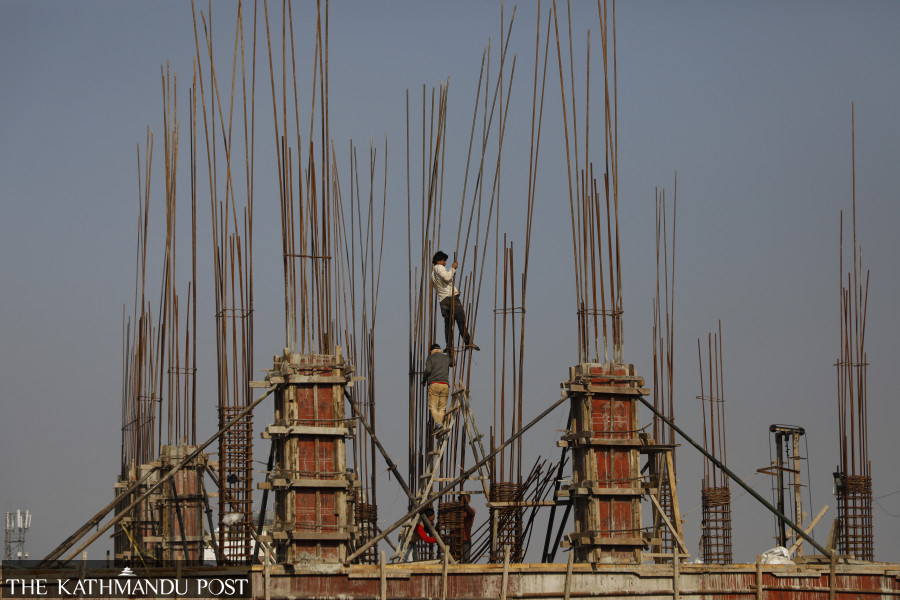Money
Home builders reel from rising cost of building materials
Demand for goods has jumped, but supply remains subdued due to low production.
Pawan Pandey
When Ram Krishna Gurung started building his house at Sahayogi Nagar in Koteshwar about nine months ago, he had estimated that the price tag would be somewhere between Rs7 million and Rs8 million, based on the cost of materials then.
But his calculation turned out to be way off.
“I had thought that a three-and-a-half-storey house could be completed for Rs7 million to Rs8 million,” said Gurung. Then the prices of building materials started to soar. “Now it looks like the cost will cross Rs10 million.” He is still trying to finish his house.
Industry insiders say serious demand and supply chain issues surfaced immediately after countries started lifting Covid restrictions. Limited distribution drove inflationary pressure globally.
Then the world faced an energy crisis. The cost of steel, cement, glass and other energy-intensive products all started to increase because of the energy crisis.
In India, more than half of its 135 coal-fired power plants are running on fumes as coal stocks run critically low. The southern neighbour burns coal to generate 70 percent of its electricity.
As the energy crisis puts pressure on energy-intensive industries in India, Nepal is feeling its effects too. Nepal imports most of its construction materials from India.
The prices of aggregate, steel, iron rod and cement have gone through the roof. Many private houses remain unfinished due to the high cost of building materials, according to contractors.
“The prices of cement and iron rods have gone up by 10 and 20 percent respectively in the past three months,” said engineer Kunjani Rai, programme director at Kuto Construction and Consultancy.
"The price of sand and pebbles has increased by Rs3,500 per truckload. Three months ago, the price was Rs24,000 per truckload, now it costs Rs27,500. With the increment in the prices of construction materials, the cost of building a house has gone up by 20 percent," says Rai.
"Three months ago, you could build a one-storey house in Kathmandu for Rs4 million. Now you need to spend Rs4.8 million."
The prices of goods, including construction materials, surged in January last year after the first wave of Covid-19 became weaker, setting off a burst of construction activity.
Consequently, demand for building materials jumped, but supply remained subdued due to low production.
The emergence of the Delta variant prompted the government to impose a second lockdown in April last year. After the restrictions were lifted in September, construction activities again picked up sharply.
“The production of construction materials was relatively low during the lockdown and restriction period,” said contractor Prakash Karki. “As soon as the Covid restrictions were lifted, demand surged and there was a huge gap in supply and demand. Materials became expensive.”
Nepal's monthly consumer price inflation climbed to its highest level in 64 months in December last year, rising to 7.11 percent from 5.32 percent in November, according to Nepal Rastra Bank.
Prices started to rise further in late February due to the Russia-Ukraine war. “The war disrupted the global fuel supply chain,” said Rai. “With the exponential growth in the prices of fuel, transportation charges too increased, making every product dearer.”
In July 2021, the Department of Transport Management allowed cargo carriers serving routes in the Tarai and hills to hike freight charges by 26 and 20 percent respectively.
Again in April this year, the government allowed them to hike freight charges by Rs13.45 per km per tonne, a hike of 13 percent. In the last two years, freight charges have gone up by at least 40 percent, according to transport entrepreneurs.
The international market price of Brent crude oil produced in the North Sea jumped 60.3 percent to $110.39 per barrel in mid-March 2022 from $68.87 per barrel a year ago, according to Nepal Rastra Bank.
The price of diesel in Nepal, the key component behind inflation, swelled to Rs143 per litre from Rs85 in April 2020.
After the prices of foreign goods entering Nepal rose, the country’s foreign exchange reserves started to deplete faster. Nepal Rastra Bank then issued a directive requiring importers to keep 100 percent margin amount to open a letter of credit (LC) to import 10 types of listed goods.
“This made construction materials even more expensive,” Rai said.
According to the central bank, Nepal’s import bill reached Rs1,308.73 billion in the first eight months of the current fiscal year, a jump of 38.6 percent from last year.
The country’s foreign exchange reserves dropped by 16.3 percent to Rs1,171 billion in mid-March 2022 from Rs1,399.03 billion in mid-July 2021.
Construction materials such as bricks, marble, tiles and ceramics are among the 10 listed goods. “While it discouraged imports, demand rose so high that construction materials became dearer,” said Rai.
According to Nepal Rastra Bank, the wholesale prices of construction materials increased by 24.24 percent year-on-year in the first eight months of the current fiscal year ended mid-March.
"Five or six years ago, it cost Rs2 to Rs2.5 million to build a four-room, one-storey house in the Valley. Until six months ago, a house with basic facilities could be constructed for around Rs3 million,” said Karki, who has been a home contractor for 10 years.
“Six months ago, I got a contract to build a one-storey house in Lokanthali, Bhaktapur. It is still not finished, but the cost has already crossed Rs3 million.”
The price of iron rods was Rs94 per kg six months ago. Now it costs Rs135 per kg. Similarly, the price of cement, both Portland Pozzolana Cement (PPC) and Ordinary Portland Cement (OPC), has increased by Rs100 per bag in the past three months.
The period between mid-February and mid-June is the peak construction season in Nepal.
While most construction materials have become expensive, the price of bricks has not changed much.
“Considering the surge in coal pieces, the price of bricks should have gone up too, but it has not increased because of high competition and low demand,” said Mahendra Bahadur Chitrakar, president of the Federation of Nepal Brick Industries.
“Brick manufacturers are incurring losses. Many factories may shut down in the coming days.” Consequently, the price of bricks may see a sharp increase next year, according to Chitrakar.
Rai too believes the price of bricks will rise in the coming days.
“Brick factories will be closed with the onset of monsoon,” Rai said. “Since they will have inventory to sell and no labourers that need to be paid daily, they may raise the prices. We too have been facing difficulties to complete contracts on time due to the price hike.”
Contractors say that people who have begun building their houses are taking a break, waiting to see if prices will fall. New projects have been put on hold due to the high cost of building materials.
“The price hike has depleted my savings,” said home builder Gurung. “I have also taken some loans to manage my household expenses.”




 12.88°C Kathmandu
12.88°C Kathmandu















